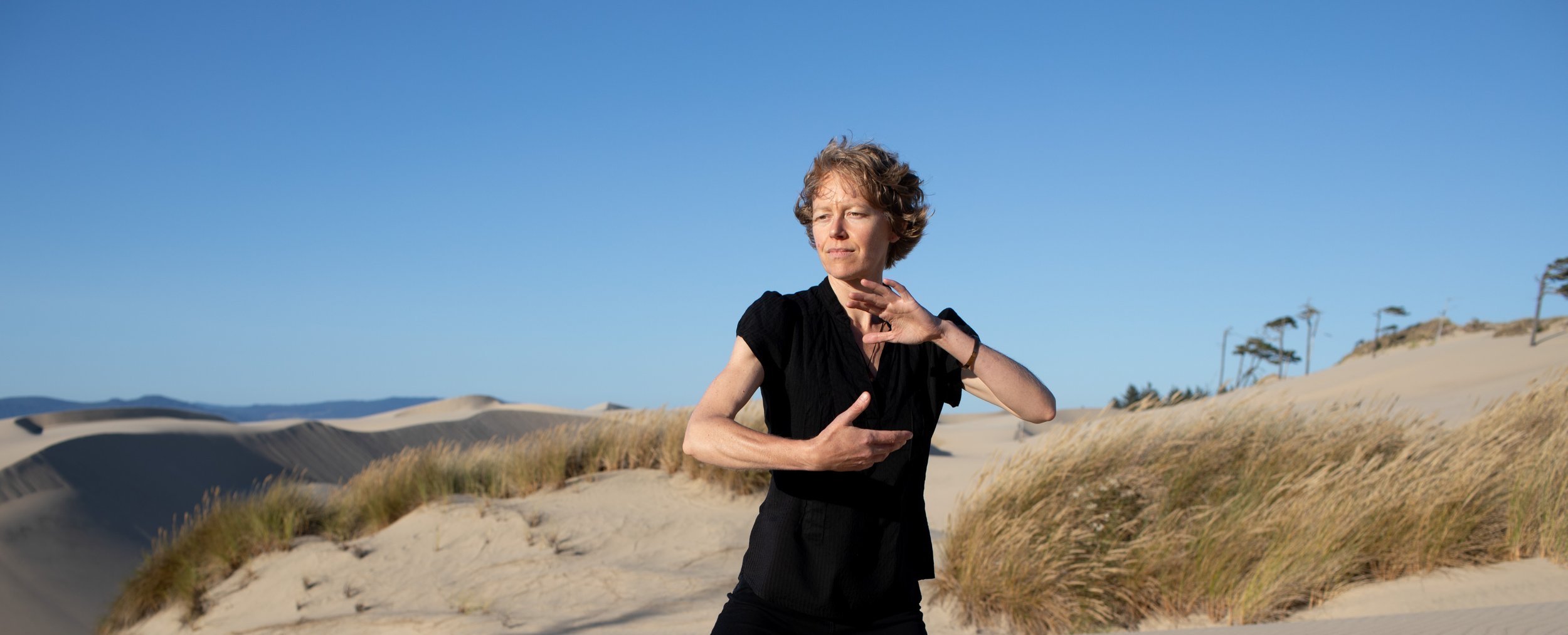the body holds it all

I, Georgia Mitchell, love movement. At five years old my career goal was to become a dancer-teacher-nurse, and I refused to wear anything but a pink bodysuit and tutu. Fortunately, desires evolve! While I haven’t worn a tutu in a long time, an interest in the body’s capacity for healing through movement has continuously guided my way.
Raised in a family focused on eastern modalities of natural healing, I began an informal study of Chinese medicine in 2012 while learning to cultivate Chinese medicinal herbs. I also discovered Qi Gong, a Chinese medical methodology designed to enhance the body’s capacity for self-healing, and began an ongoing study with Robert Bates of Bellingham, WA in 2015. Qi Gong encompasses a vast system of movement and meditation forms, traditionally passed down within specific regions and families in China, and becoming more broadly accessible in the West in recent years. Unlike Tai Ji (Tai Chi), which has roots primarily in the martial lineages, Qi Gong originated within the Chinese medical tradition and ancient Daoist longevity practices. I began studying with Lindsey Wei in the Wudang lineage of internal martial arts and Daoist meditation in 2022, and relocated to the beautiful Willamette Valley of western Oregon. In the years since I have been expanding my range of somatic modalities, including mentorship with Liz Koch of CoreAwareness™, and a ten-week apprenticeship in Resistance Flexibility and Strength Training (RFST) with Eric Dermond, lead trainer at The Genius of Flexibility studio in Boston, MA. I’m currently earning my certification as a Stretch Coach through the National Academy of Sports Medicine (NASM).
I understands each of these practices as a gateway: an entry point into the vast terrain of the body. The first steps within this territory involve developing familiarity, the ability to differentiate sensations of muscle, fluid, organs and bone. Once an internal orientation has been established, it becomes possible to apply methods to shift the system in particular directions — toward increasing fluidity, articulation, engagement, and vitality, all of which lead to the greater resilience that is health. The context of Chinese medicine paired with my background in farming and ecology gives me an ability to situate human experience within the larger ecosystem upon which it depends.
Between my mid-twenties and thirties, I spent ten years in the fields of ornamental and restoration horticulture. My work as a native plant seed collector, traversing five counties in northwest Washington and over the Cascade Crest, honed my eye for the flowering and maturation of native plant species across the landscape, an expression of the movement of qi through ecosystems. This training developed a precision of attention and ability to sense timing and location that I now apply to my work with the body. Internal and external landscapes are equally varied in their expression, and the ability to successfully navigate the outside world is often dependent upon the clarity and vibrance of the internal one.
Growing up in the Silver Valley of northern Idaho, I experienced the foundations of a lifelong inquiry into the interplay between land, trauma, and healing, and the role of movement arts in this reintegration. As a child I witnessed the ecological impacts of mining pollution, the societal pain of poverty, and the slow regeneration of the Coeur d’Alene River basin. Learning Japanese martial and healing arts from an early age, my relationship with somatic practice is long, deep, and multi-layered. Contrary to the beliefs of modern culture, the path of transformation through the body is slow; it requires patience, perseverance, and letting go. It recognizes that life is shaped by forces beyond our control. It is a path about beginnings, and endings, and beginning anew.
acknowledgements
A big thank you to Dan Haberly and Oregon Dunes National Recreation Area for the wonderful photography. Appreciation also to Clayton Holmes, Aaron Lee, and Erik Mclean on Unsplash for the Private Sessions, Contact, and Land Repair page images.
Gratitude to the original inhabitants of the Willamette Valley, Klamath, Cascades, and coastal ecoregions: the indigenous nations and native species. May these lands and waters be restored for your benefit.
Thank you.

